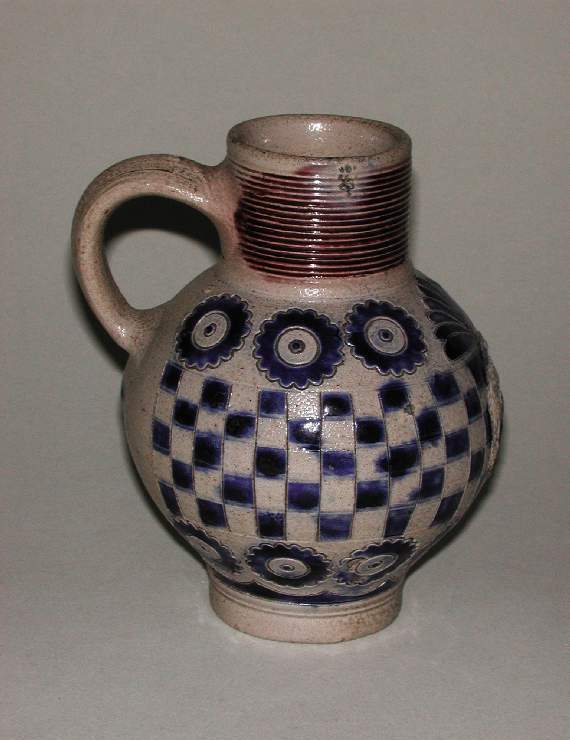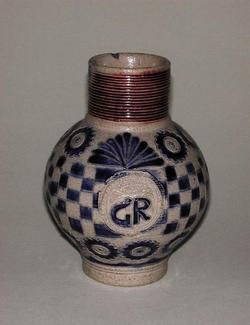Current Location: In storage
Maker(s)
Production:
Unidentified Westerwald pottery
Entities
Categories
Description
Grey salt-glazed stoneware with incised and applied moulded decoration painted in cobalt-blue and manganese-purple
Grey stoneware, thrown and turned, with incised and applied moulded decoration, painted in cobalt-blue and manganese-purple before salt-glazing. The globular jug stands on a solid disc base. It has a cylindrical neck with horizontal turned rilling, and a small strap handle of D section, which has a hole at the top to take a mount. The front is applied with a circular medallion enclosing the cypher GR for George I (or George II) of England under a crown. Above it is a fan-shaped motif, and on each side, a broad band of chequer pattern with three impressed rosettes above and below. The design is picked out in cobalt-blue and the neck is painted in manganese-purple except for the area below the handle.
Notes
History note: Bought at Great Yarmouth in 1893 by S.J. Freeman of Cambridge; bought (in 1893?) by Dr J.W.L. Glaisher, FRS, Trinity College, Cambridge
Legal notes
Dr J. W. L. Glaisher Bequest
Measurements and weight
Height: 12.9 cm
Width: 11.2 cm
Acquisition and important dates
Method of acquisition: Bequeathed
(1928-12-07)
by
Glaisher, J. W. L., Dr
Dating
George I
Circa
1714
-
1727
Note
Stoneware production in the Westerwald was at first centred on the villages of Höhr, Grenzau and Grenzhausen, and spread to nearby villages, such as Hilgert. It is rarely possible to identify the place of production for individual pots. Large quantities of Westerwald drinking vessels were exported to England in the 17th and 18th centuries. This jug was probably made during the reign of George I (1714-27) but might have been made in the early part of the reign of George II. A less bulbous jug in the Victoria and Albert Museum decorated with chequer pattern and a different medallion with the cipher,GR, is attributed probably to the reign of George II c. 1740 (Circ.88.1919).
School or Style
Baroque
Components of the work
Decoration
composed of
cobalt
manganese
Surface
composed of
salt-glaze
Base
Diameter 5 cm
Body
Neck
Materials used in production
grey
Stoneware
Inscription or legends present
- Text: GR
- Location: On front
- Method of creation: Moulded in relief and painted in blue
- Type: Initials
References and bibliographic entries
Identification numbers
Accession number: C.2049-1928
Primary reference Number: 73049
Old object number: 1268
Stable URI
Audit data
Created: Saturday 6 August 2011
Updated: Tuesday 30 April 2024
Last processed: Tuesday 15 July 2025
Associated departments & institutions
Owner or interested party:
The Fitzwilliam Museum
Associated department:
Applied Arts






